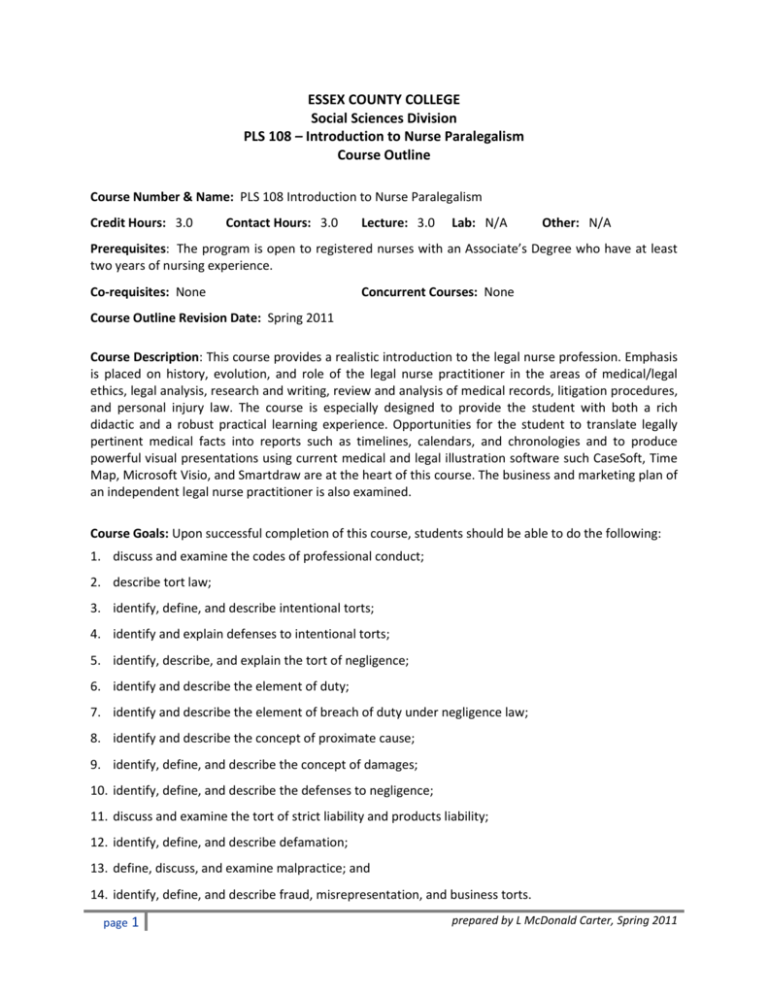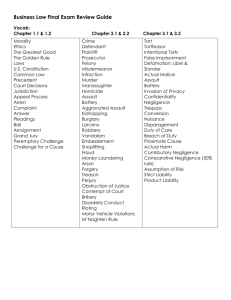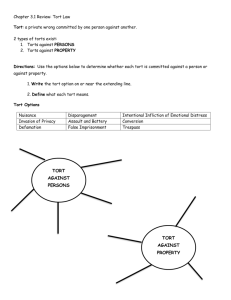
ESSEX COUNTY COLLEGE
Social Sciences Division
PLS 108 – Introduction to Nurse Paralegalism
Course Outline
Course Number & Name: PLS 108 Introduction to Nurse Paralegalism
Credit Hours: 3.0
Contact Hours: 3.0
Lecture: 3.0
Lab: N/A
Other: N/A
Prerequisites: The program is open to registered nurses with an Associate’s Degree who have at least
two years of nursing experience.
Co-requisites: None
Concurrent Courses: None
Course Outline Revision Date: Spring 2011
Course Description: This course provides a realistic introduction to the legal nurse profession. Emphasis
is placed on history, evolution, and role of the legal nurse practitioner in the areas of medical/legal
ethics, legal analysis, research and writing, review and analysis of medical records, litigation procedures,
and personal injury law. The course is especially designed to provide the student with both a rich
didactic and a robust practical learning experience. Opportunities for the student to translate legally
pertinent medical facts into reports such as timelines, calendars, and chronologies and to produce
powerful visual presentations using current medical and legal illustration software such CaseSoft, Time
Map, Microsoft Visio, and Smartdraw are at the heart of this course. The business and marketing plan of
an independent legal nurse practitioner is also examined.
Course Goals: Upon successful completion of this course, students should be able to do the following:
1. discuss and examine the codes of professional conduct;
2. describe tort law;
3. identify, define, and describe intentional torts;
4. identify and explain defenses to intentional torts;
5. identify, describe, and explain the tort of negligence;
6. identify and describe the element of duty;
7. identify and describe the element of breach of duty under negligence law;
8. identify and describe the concept of proximate cause;
9. identify, define, and describe the concept of damages;
10. identify, define, and describe the defenses to negligence;
11. discuss and examine the tort of strict liability and products liability;
12. identify, define, and describe defamation;
13. define, discuss, and examine malpractice; and
14. identify, define, and describe fraud, misrepresentation, and business torts.
page 1
prepared by L McDonald Carter, Spring 2011
Measurable Course Performance Objectives (MPOs): Upon successful completion of this course,
students should specifically be able to do the following:
1. Discuss and examine the codes of professional conduct:
1.1 discuss and examine judicial conduct;
1.2 discuss and examine attorney ethical standards; and
1.3 discuss and examine paralegal professionalism
2. Describe tort law:
2.1
2.2
2.3
2.4
2.5
compare tort law to other forms/areas of law;
explain the process of bringing a tort case;
describe the discovery process in a civil case;
describe the trial of a civil case; and
describe alternative dispute resolution
3. Identify, define, and describe intentional torts:
3.1
3.2
3.3
3.4
3.5
3.6
3.7
3.8
identify and describe the problem with intentional torts;
identify, define, and describe the torts of assault and battery;
identify, define, and describe the tort of false imprisonment;
identify, define, and describe the tort of intentional infliction of emotional distress;
identify, define, and describe the tort of malicious prosecution;
identify, define, and describe intentional torts involving property, particularly trespass;
identify, define, and describe nuisance actions; and
identify, define, and describe trespass to chattels
4. Identify and explain defenses to intentional torts:
4.1 identify, define, and describe self defense;
4.2 identify and describe the defense of consent;
4.3 identify, define, and describe the defenses of duress, necessity, compulsion, and coercion;
4.4 identify, define, and describe the defense of intoxication;
4.5 identify, define, and describe the defense of mistake;
4.6 identify and describe the defense of age;
4.7 identify, define, and describe the defense of insanity;
4.8 identify, define, and describe the defense of immunity;
4.9 identify, define, and describe the defense of privilege;
4.10 identify, define, and describe the defense of statutes of limitation; and
4.11 identify, define, and describe defenses available to codefendants
5. Identify, describe, and explain the tort of negligence:
5.1
5.2
5.3
5.4
5.5
page 2
identify, define, describe, and explain the tort of negligence;
define, describe, and explain the history of negligence;
identify, define, describe, and examine the four elements of negligence;
describe the lawyers who represent plaintiffs and defendants; and
describe how to obtain information from a client
prepared by L McDonald Carter, Spring 2011
Measurable Course Performance Objectives (MPOs) (continued):
6. Identify and describe the element of duty:
6.1
6.2
6.3
6.4
6.5
identify and define the element of duty;
explain how the courts determine duty;
identify, define, and describe the element of duty derived from a social relationship;
identify, define, and describe premises liability; and
describe and explain duty to third parties
7. Identify and describe the element of breach of duty under negligence law:
7.1
7.2
7.3
7.4
identify and describe breach of duty;
identify and describe professionals’ standard of care;
explain court doctrines that help to determine the element of breach of duty; and
describe evidence relationship to breach of duty
8. Identify and describe the concept of proximate cause:
8.1
8.2
8.3
8.4
8.5
describe the concept of proximate cause;
describe court-created tests for proximate cause;
describe the requirements for the plaintiff to plead proximate cause;
describe the application of the concept of proximate cause to multiple defendants; and
identify and describe intervening causes
9. Identify, define, and describe the concept of damages:
9.1 identify, define, and describe damages; and
9.2 evaluate a case for potential damages
10. Identify, define, and describe the defenses to negligence:
10.1 identify, define, and describe the concept of contributory negligence;
10.2 identify, define, and describe the concept of comparative negligence; and
10.3 compare and contrast contributory negligence and comparative negligence
11. Discuss and examine the tort of strict liability and products liability:
11.1 identify, define, and describe the tort of strict liability; and
11.2 identify, define, and describe the tort of products liability
12. Identify, define, and describe defamation:
12.1 identify, define, and describe the tort of defamation
13. Define, discuss, and examine malpractice:
13.1 identify, define, and describe malpractice; and
13.2 identify, define, and describe medical malpractice
page 3
prepared by L McDonald Carter, Spring 2011
Measurable Course Performance Objectives (MPOs) (continued):
14. Identify, define, and describe fraud, misrepresentation, and business torts:
14.1 identify, define, and describe the tort of fraud;
14.2 identify, define, and describe the tort of negligent misrepresentation;
14.3 identify, define, and describe the tort of interference with contract;
14.4 identify, define, and describe the tort of deceptive trade practices;
14.5 identify, define, and describe consumer protection laws;
14.6 identify, define, and describe sexual harassment; and
14.7 identify, define, and describe worker’s compensation
Methods of Instruction: Instruction will consist of a combination of any of the following instructional
methods: legal case reviews, lectures, group activities, role play, oral presentations, document drafting,
charts, essays, research assignments, films, cable, news and television programs, field trips, and
community outreach projects.
Outcomes Assessment: Checklist rubrics are used to evaluate non-test type assessment instruments
(e.g., debates, exercises, and projects) for the presence of course objectives. Data collected will be
analyzed to provide direction for the improvement of program instruction, viability of class assignments,
relevancy of assigned course materials, and evaluation of instructional time spent on specific topics.
Course Requirements: All students are required to:
1.
Maintain regular and prompt attendance to all class sessions.
2.
Complete homework assignments (if applicable).
3.
Complete all written and oral exercises (scored grading) inside and outside of class as assigned.
4.
Complete the Final Project as assigned.
5.
Voluntarily participate in class discussions and class exercises.
6.
Complete all assessment activities as scheduled.
7.
Follow any specific class requirements mandated by the instructor.
page 4
prepared by L McDonald Carter, Spring 2011
Methods of Evaluation: Final course grades will be computed as follows:
% of
final course grade
Grading Components
Attendance/Class Participation
5 – 10%
Attendance points will be computed based on the ratio of the
number of days attending the course during a regular semester
(i.e., 28 contact days). A similar procedure will be used to
determine participation points.
Medical Record Organization
30%
The medical record organization, which requires students to
identify, analyze, and organize medical records based on the
medical fact pattern and legal issues, is a practical exercise
designed to assess students’ abilities to organize large volumes
of information.
Debate: Plaintiff v Defendant with Software Presentation
20%
Debates are oral arguments designed to provide students with
an opportunity to enhance their oral communication and
software (e.g., Smartdraw, Microsoft Visio, and LexisNexis
CaseSoft Suite) utilization skills while engaging in legal analysis
of a given set of medical facts related to course objectives.
New Jersey Law Diary Exercise
10%
The law diary exercise is designed to demonstrate the use of the
NJ Law Diary and Manual as a marketing tool.
Final Project
30%
The final project consists of the analysis of a medical record,
preparation of reports of the medical facts using appropriate
computer software, preparation of reports of the medical facts
analyzing ethical and legal issues, recommendations of a case
based on merit, visual productions of medical facts, and a final
report for the attorney with tabs and pagination.
Extra Credit Opportunities
5 – 10%
o Voter registration – The student should provide written
evidence of participation in the electoral process.
o Notary Public – Students are encouraged to research,
process, and complete a notary public application for
approval to include on their resumes to enhance their
marketability.
o Membership in Paralegal Association of New Jersey (PANJ) –
Students are encouraged to join the Paralegal Association of
New Jersey to include on their resume to enhance their
marketability.
NOTE: The instructor will determine (as appropriate) the specific component(s) appropriate for the
course and provide specific weights which lie in the above-given ranges at the beginning of the
semester.
page 5
prepared by L McDonald Carter, Spring 2011
Academic Integrity: Dishonesty disrupts the search for truth that is inherent in the learning process and
so devalues the purpose and the mission of the College. Academic dishonesty includes, but is not
limited to, the following:
plagiarism – the failure to acknowledge another writer’s words or ideas or to give proper credit
to sources of information;
cheating – knowingly obtaining or giving unauthorized information on any test/exam or any
other academic assignment;
interference – any interruption of the academic process that prevents others from the proper
engagement in learning or teaching; and
fraud – any act or instance of willful deceit or trickery.
Violations of academic integrity will be dealt with by imposing appropriate sanctions. Sanctions for acts
of academic dishonesty could include the resubmission of an assignment, failure of the test/exam,
failure in the course, probation, suspension from the College, and even expulsion from the College.
Student Code of Conduct: All students are expected to conduct themselves as responsible and
considerate adults who respect the rights of others. Disruptive behavior will not be tolerated. All
students are also expected to attend and be on time for all class meetings. No cell phones or similar
electronic devices are permitted in class. Please refer to the Essex County College student handbook,
Lifeline, for more specific information about the College’s Code of Conduct and attendance
requirements.
NOTE: Students shall conduct themselves in a professional manner at all times. See National Federation
of Paralegals Associations, Inc. Model Code of Ethics and Professional Responsibility and Guidelines for
Enforcement.
page 6
prepared by L McDonald Carter, Spring 2011
Course Content Outline: based on the text Legal and Ethical Issues in Nursing, 5th edition, by C Wacker
Guido; published by Pearson/Prentice Hall.
Unit
Topics to be Covered
1
Course Introduction – history of legal nursing; standards of care and deviations
of standards of care; hospital policies and procedures; reference section: federal
acts; accreditation and credentialing; medical-legal research
2
Legal & Ethical Aspects of the Legal Nurse Consultant – Torts; personal injury;
product liability; medical malpractice; medical record tampering
3
Preparation for Discovery – Depositions; interrogations
4
Selection, Review & Preparation of Testifying – Expert witness; preparation of
exhibits; demonstrative evidence; trial preparation; trial
5
How to Use the Computer to Write Reports – The computer and report writing;
Microsoft Word; Microsoft Excel; Microsoft Visio; treatment calendar
6
Software: LexisNexis CaseSoft Suite – LexisNexis CaseMap; Lexis Nexis TimeMap;
LexisNexis TextMap; LexisNexis NoteMap; LexisNexis DepMap
7
Medical Record Organization – Medical records review; report presentation
8
Types of Reports – Report writing; narrative report; chronology; verbal report;
fee schedule and retainer
9
Review Case for Merit – How to review a case for merit
10
Tab, Paginate, Reference and Index – Organize, tab, and paginate a medical
record; referencing and indexing; how to create an outline
11
Demonstrative Evidence – Timeline and chronology; how to write a timeline;
how to write a chronology; event calendar; treatment calendar; medical records
of interest
NOTE: In PLS 108, the instructor must cover the 11 units listed above minimally in any reasonable order
throughout the duration of the semester/term. In addition, the instructor must provide economic,
historic, political, and social context for the relevant aspects of the legal process.
NOTE: Guidelines for the Final Project are as follows: The student will analyze and report on medical
legal ethics in a Capstone project requiring the preparation of two written reports and two visual
presentations from the same fact pattern. One report and visual presentation is for the attorney of the
plaintiff and the other is for the defendant. As the professional legal nurse consultant and nurse
paralegal the student must submit a memorandum and a brief based on documented professional
opinion. A professional report in the standard format including pagination and tabs is required. The
visual presentations must use Microsoft PowerPoint, Microsoft Visio, Smartdraw, and LexisNexis
CaseSoft Suite for graphics and illustrations.
page 7
prepared by L McDonald Carter, Spring 2011





